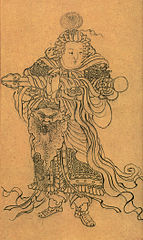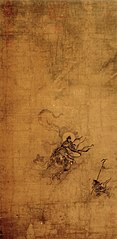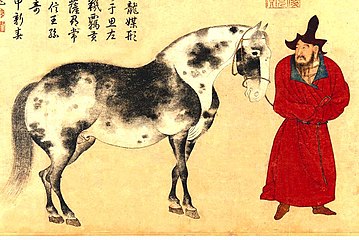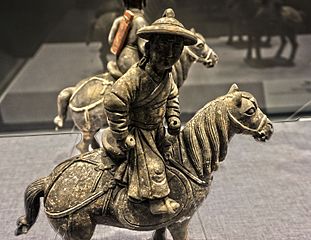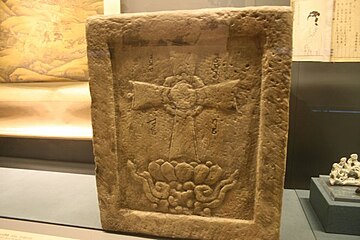Yuan dynasty
Great Yuan | |||||||||||||||
|---|---|---|---|---|---|---|---|---|---|---|---|---|---|---|---|
| 1271–1368 | |||||||||||||||
![Yuan dynasty (c. 1290)[note 1]](https://upload.wikimedia.org/wikipedia/commons/thumb/0/01/Yuan_Dynasty_revised.png/250px-Yuan_Dynasty_revised.png) Yuan dynasty (c. 1290)[note 1] | |||||||||||||||
| Status | Khagan-ruleddivisionof theMongol Empire[note 2] Conquest dynastyofImperial China | ||||||||||||||
| Capital | |||||||||||||||
| Common languages | |||||||||||||||
| Official script | 'Phags-pa script[5] | ||||||||||||||
| Religion | Buddhism(Tibetan Buddhismasde factostate religion),Confucianism,Taoism,Shamanism,MongolianTengrism/ChineseHeaven worship,Chinese folk religion,Chinese Nestorian Christianity,Roman Catholic Christianity,Judaism,Chinese Manichaeism,Islam | ||||||||||||||
| Government | Monarchy | ||||||||||||||
| Emperor[note 3] | |||||||||||||||
• 1260–1294 | Kublai | ||||||||||||||
• 1332–1368 | Toghon Temür | ||||||||||||||
| Chancellor | |||||||||||||||
• 1264–1282 | Ahmad Fanakati | ||||||||||||||
• 1340–1355 | Toqto'a | ||||||||||||||
| Historical era | Postclassical Era | ||||||||||||||
| 5 May 1260 | |||||||||||||||
• Kublai's proclamation of the dynastic name "Great Yuan"[8] | 5 November 1271 | ||||||||||||||
| 1268–1273 | |||||||||||||||
| 4 February 1276 | |||||||||||||||
| 19 March 1279 | |||||||||||||||
| 1351–1368 | |||||||||||||||
• Fall ofKhanbaliq | 14 September 1368 | ||||||||||||||
• Formation ofNorthern Yuan dynasty | 1368–1388 | ||||||||||||||
| Area | |||||||||||||||
| 1310[9] | 11,000,000 km2(4,200,000 sq mi) | ||||||||||||||
| Currency | Jiaochaobanknotes,Chinese cash | ||||||||||||||
| |||||||||||||||
| History of Mongolia |
|---|
 |
| Part ofa serieson the |
| History of China |
|---|
TheYuan dynasty(Chinese:NguyênTriều;pinyin:Yuáncháo), officially theGreat Yuan[10](Chinese:ĐạiNguyên;pinyin:Dà Yuán;Mongolian:ᠶᠡᠬᠡ
ᠶᠤᠸᠠᠨ
ᠤᠯᠤᠰ,Yeke Yuwan Ulus,literally "Great Yuan State"[note 4]), was aMongol-ledimperial dynasty of Chinaand asuccessor stateto theMongol Empireafterits division.[note 2]It was established byKublai(Emperor Shizu or Setsen Khan), the fifth khagan-emperor of the Mongol Empire from theBorjiginclan, and lasted from 1271 to 1368. InChinese history,the Yuan dynasty followed theSong dynastyand preceded theMing dynasty.
AlthoughGenghis Khan's enthronement asKhaganin 1206 was described inChineseas theHan-style title ofEmperor[note 3][6]and theMongol Empirehad ruled territories including modern-daynorthern Chinafor decades, it was not until 1271 that Kublai Khan officially proclaimed the dynasty in the traditional Han style,[13]and the conquest was not complete until 1279 when the Southern Song dynasty was defeated in theBattle of Yamen.His realm was, by this point, isolated from the other Mongol-led khanates and controlled most of modern-dayChinaand its surrounding areas, including modern-dayMongolia.[14]It was the first dynasty founded by a non-Han ethnicity that ruled all ofChina proper.[15]: 312 [16]In 1368, following the defeat of the Yuan forces by the Ming dynasty, the Genghisid rulers retreated to theMongolian Plateauand continued to rule until 1635 when they surrendered to theLater Jin dynasty(which later evolved into theQing dynasty). The rump state is known inhistoriographyas theNorthern Yuan dynasty.
After the division of the Mongol Empire, the Yuan dynasty was the khanate ruled by the successors ofMöngke.In official Chinese histories, the Yuan dynasty bore theMandate of Heaven.The dynasty was established by Kublai Khan, yet he placed his grandfather Genghis Khan on the imperial records as the official founder of the dynasty and accorded him thetemple nameTaizu.[note 3]In the edict titledProclamation of the Dynastic Nameissued in 1271,[8]Kublai announced the name of the new dynasty as Great Yuan and claimed the succession of former Chinese dynasties from theThree Sovereigns and Five Emperorsto theTang dynasty.[8]Some of the Yuan emperors mastered theChinese language,while others only used their nativeMongolian languageand the'Phags-pa script.[17]
Kublai, as aKhagan(Great Khan) of the Mongol Empire from 1260, had claimed supremacy over the other successor Mongol khanates: theChagatai,theGolden Horde,and theIlkhanate,before proclaiming as theEmperor of Chinain 1271. As such, the Yuan was also sometimes referred to as theEmpire of the Great Khan.However, while the claim of supremacy by the Yuan emperors was at times recognized by the western khans, their subservience was nominal and each continued its own separate development.[18][19][page needed]
Name[edit]
| Yuan dynasty | |||||||||||||||||||||||||||||||
|---|---|---|---|---|---|---|---|---|---|---|---|---|---|---|---|---|---|---|---|---|---|---|---|---|---|---|---|---|---|---|---|
 "Yuan dynasty" inChinese characters(top) and "Great Yuan State" (Yehe Yüan Ulus,a modern form) inMongolian script(bottom) | |||||||||||||||||||||||||||||||
| Chinese | Nguyên triều | ||||||||||||||||||||||||||||||
| Literal meaning | "Yuan dynasty" | ||||||||||||||||||||||||||||||
| |||||||||||||||||||||||||||||||
| Dynastic name | |||||||||||||||||||||||||||||||
| Chinese | Đại nguyên | ||||||||||||||||||||||||||||||
| Literal meaning | Great Yuan | ||||||||||||||||||||||||||||||
| |||||||||||||||||||||||||||||||
| Alternative official full name: ᠳᠠᠢ ᠶᠤᠸᠠᠨ ᠶᠡᠬᠡ ᠮᠣᠩᠭᠣᠯ ᠤᠯᠤᠰ Dai Yuwan Yeqe Mongɣul Ulus | |||||||||||||||||||||||||||||||
| Traditional Chinese | Đại nguyên đại mông cổ quốc | ||||||||||||||||||||||||||||||
| Simplified Chinese | Đại nguyên đại mông cổ quốc | ||||||||||||||||||||||||||||||
| Literal meaning | "Great Yuan" (Middle Mongol transliteration of Chinese "Dà Yuán" ) Great Mongol State | ||||||||||||||||||||||||||||||
| |||||||||||||||||||||||||||||||
In 1271,Kublai Khanimposed the nameGreat Yuan(Chinese:Đại nguyên;pinyin:Dà Yuán), establishing the Yuan dynasty.[10]"Dà Yuán" (Đại nguyên) is from a clause "Đại tai càn nguyên"(dà zāi Qián Yuán;'Great is Qián', 'the Primal') in theCommentarieson theI Chingsection[20]regarding thefirst hexagram(Càn).[8]TheMongolian-languagecounterpart wasDai Ön Ulus,also rendered asIkh Yuan ÜlsorYekhe Yuan Ulus.In Mongolian,Dai Öna borrowing from Chinese, was often used in conjunction with the "Yeke Mongghul Ulus" (Đại mông cổ quốc;'Great Mongol State'), which resulted in the formᠳᠠᠢ
ᠥᠨ
ᠶᠡᠬᠡ
ᠮᠣᠩᠭᠣᠯ
ᠤᠯᠤᠰ(Đại nguyên đại mông cổ quốc;Dai Ön Yeqe Mongɣul Ulus,lit. "Great Yuan – Great Mongol State" )[21]orᠳᠠᠢ ᠦᠨ
ᠺᠡᠮᠡᠺᠦ
ᠶᠡᠬᠡ
ᠮᠣᠩᠭᠣᠯ
ᠤᠯᠤᠰ(Dai Ön qemeqü Yeqe Mongɣol Ulus,lit. "Great Mongol State called Great Yuan" ).[22]
As per contemporary historiographical norm, "Yuan dynasty" typically refers to the realm with its main capital inDadu(modern-dayBeijing). However, theHan-style dynastic name "Great Yuan" and the claim to Chinese political orthodoxy were meant for the entire Mongol Empire.[8][12]This usage is seen in the writings, including non-Chinese texts, produced during the time of the Yuan dynasty.[12]In spite of this, "Yuan dynasty" is rarely used in the broad sense of the definition by modern scholars due to thedivision of the Mongol Empire.[citation needed]
The Yuan dynasty is sometimes also called the "Mongol dynasty" by westerners,[23]: 269 akin to theQing dynastysometimes being referred to as the "Manchu dynasty"[24]or "Manchu Dynasty of China".[25]: 365 Furthermore, the Yuan is sometimes known as the "Empire of the Great Khan" or "Khanate of the Great Khan",[26]: 48 since Yuan emperors held the nominal title ofGreat Khan;these appeared on some Yuan maps. However, both terms can also refer to the khanate within the Mongol Empire directly ruled by Great Khans before the actual establishment of the Yuan dynasty by Kublai Khan in 1271.
History[edit]
Background[edit]
Genghis Khanunited the Mongol tribes of the steppes and becameGreat Khanin 1206.[27]He and his successors expanded the Mongol empire across Asia. Under the reign of Genghis' third son,Ögedei Khan,the Mongolsdestroyedthe weakenedJin dynastyin 1234, conquering most ofnorthern China.[28]Ögedei offered his nephew Kublai a position inXingzhou,Hebei.Kublai was unable to read Chinese but had several Han teachers attached to him since his early years by his motherSorghaghtani.He sought the counsel of Chinese Buddhist and Confucian advisers.[29]Möngke Khansucceeded Ögedei's son,Güyük,as Great Khan in 1251.[30]He granted his brother Kublai control over Mongol held territories in China.[31]Kublai built schools for Confucian scholars, issuedpaper money,revived Chinese rituals, and endorsed policies that stimulated agricultural and commercial growth.[32]He adopted as his capital city Kaiping inInner Mongolia,later renamedShangdu.[33]
Many Han Chinese and Khitan defected to the Mongols to fight against the Jin. Two Han Chinese leaders,Shi Tianze,Liu Heima(Lưu hắc mã,aka Liu Ni),[34]and the KhitanXiao Zhala(Tiêu trát lạt) defected and commanded the 3 Tumens in the Mongol army. Liu Heima and Shi Tianze served Ögedei Khan.[35]: 129–130 Liu Heima and Shi Tianxiang led armies against Western Xia for the Mongols.[36]: 175 There were 4 Han Tumens and 3 Khitan Tumens, with each Tumen consisting of 10,000 troops. The three Khitan Generals Shimobeidier (Thạch mạt bột điệt nhi), Tabuyir (Tháp bất dĩ nhi), and Zhongxi, the son of Xiaozhaci (Tiêu trát thứ chi tử trọng hỉ) commanded the three Khitan Tumens and the four Han Generals Zhang Rou, Yan Shi, Shi Tianze, and Liu Heima commanded the four Han tumens under Ögedei Khan.[37][38]
Möngke Khan commenced a military campaign against the ChineseSong dynastyin southern China.[39]The Mongol force that invaded southern China was far greater than the force they sent to invade the Middle East in 1256.[40]He died in 1259 without a successor.[41]Kublai returned from fighting the Song in 1260 when he learned that his brother,Ariq Böke,was challenging his claim to the throne.[42]Kublai convened a kurultai in Kaiping that elected him Great Khan.[43]A rival kurultai in Mongolia proclaimed Ariq Böke Great Khan, beginning a civil war.[44]Kublai depended on the cooperation of his Chinese subjects to ensure that his army received ample resources. He bolstered his popularity among his subjects by modeling his government on the bureaucracy of traditional Chinese dynasties and adopting the Chinese era name of Zhongtong.[45]Ariq Bökewas hampered by inadequate supplies and surrendered in 1264.[46]All of the three western khanates (Golden Horde,Chagatai KhanateandIlkhanate) became functionally autonomous, and only the Ilkhans truly recognized Kublai as Great Khan.[47][48]Civil strife hadpermanently divided the Mongol Empire.[49]
Rule of Kublai Khan[edit]
Early years[edit]
Instability troubled the early years of Kublai Khan's reign. Ögedei's grandsonKaidu( khai đô ) refused to submit to Kublai and threatened the western frontier of Kublai's domain.[4][50]The hostile but weakened Song dynasty remained an obstacle in the south.[4]Kublai secured the northeast border in 1259 by installing the hostage princeWonjongas the ruler of theKingdom of Goryeo(Korea), making it a Mongol tributary state.[3][4]Kublai betrothed one of his daughters to the prince to solidify the relationship between the two houses.[51]Korean women were sent to the Yuan court as tribute and one concubine became theempressof the Yuan dynasty.[52]Kublai was also threatened by domestic unrest. Li Tan, the son-in-law of a powerful official, instigated a revolt against Mongol rule in 1262. After successfully suppressing the revolt, Kublai curbed the influence of the Han advisers in his court.[53]He feared that his dependence on Chinese officials left him vulnerable to future revolts and defections to the Song.[54]
Kublai's government after 1262 was a compromise between preserving Mongol interests in China and satisfying the demands of his Chinese subjects.[55]He instituted the reforms proposed by his Chinese advisers by centralizing the bureaucracy, expanding the circulation of paper money, and maintaining thetraditional monopolies on saltandiron.[56]He restored the Imperial Secretariat and left the local administrative structure of past Chinese dynasties unchanged.[57]However, Kublai rejected plans to revive the Confucianimperial examinationsand divided Yuan society into three classes with the Han occupying the lowest rank until the conquest of theSong dynastyand its people, who made up the fourth class, the Southern Chinese. Kublai's Chinese advisers still wielded significant power in the government, sometimes more than high officials, but their official rank was nebulous.[56]
Founding the dynasty[edit]
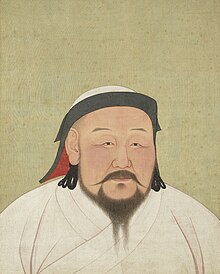
Kublai readied the move of the Mongol capital fromKarakorumin Mongolia toKhanbaliqin 1264,[58]constructing a new city near the formerJurchencapitalZhongdu,now modernBeijing,in 1266.[59]In 1271, Kublai formally claimed theMandate of Heavenand declared that 1272 was the first year of the Great Yuan (Đại nguyên) in the style of a traditional Chinese dynasty.[60]The name of the dynasty is first attested in theI Chingand describes the "origin of the universe" or a "primal force".[61]Kublai proclaimed Khanbaliq the Daidu (Đại đô;Dàdū;'Great Capital') of the dynasty.[62]The era name was changed to Zhiyuan to herald a new era of Chinese history.[63]The adoption of a dynastic name legitimized Mongol rule by integrating the government into the narrative of traditional Chinese political succession.[64]Kublai evoked his public image as a sage emperor by following the rituals of Confucian propriety and ancestor veneration,[65]while simultaneously retaining his roots as a leader from the steppes.[64]
Kublai Khan promoted commercial, scientific, and cultural growth. He supported the merchants of theSilk Roadtrade network by protecting theMongol postal system,constructing infrastructure, providing loans that financed trade caravans, and encouraging the circulation of paperjiaochaobanknotes. During the beginning of the Yuan dynasty, the Mongols continued issuingcoins;however, underKülüg Khancoins were completely replaced by paper money. It was not until the reign ofToghon Temürthat the government of the Yuan dynasty would attempt to reintroduce copper coinage for circulation.[66]ThePax Mongolica,Mongol peace, enabled the spread of technologies, commodities, and culture between China and the West.[67]Kublai expanded theGrand Canalfrom southern China to Daidu in the north.[68]Mongol rule was cosmopolitan under Kublai Khan.[69]He welcomed foreign visitors to his court, such as the Venetian merchantMarco Polo,who wrote the most influential European account of Yuan China.[70]Marco Polo's travels would later inspire many others likeChristopher Columbusto chart a passage to the Far East in search of its legendary wealth.[71]
Military conquests and campaigns[edit]

 )appears on all the territory.[72]
)appears on all the territory.[72]After strengthening his government in northern China, Kublai pursued an expansionist policy in line with the tradition of Mongol and Chinese imperialism. He renewed a massive drive against the Song dynasty to the south.[73]Kublai besiegedXiangyang( tương dương ) between 1268 and 1273,[74]the last obstacle in his way to capture the rich Yangtze River basin.[58]An unsuccessful naval expedition was undertakenagainst Japanin 1274.[75]The Duan family ruling theKingdom of Dali( đại lý ) in Yunnan submitted to the Yuan dynasty as vassals and were allowed to keep their throne, militarily assisting the Yuan dynasty against the Song dynasty in southern China.
The Duan family still ruled Dali relatively independently during the Yuan dynasty.[76]: 146 TheTusichieftains and local tribe leaders and kingdoms in Yunnan, Guizhou and Sichuan submitted to Yuan rule and were allowed to keep their titles. The Han Chinese Yang family ruling theChiefdom of Bozhou,which was recognized by both the Song and Tang dynasty, also received recognition by the Mongols in the Yuan dynasty, and later by theMing dynasty.The Luo clan in Shuixi led by Ahua were recognized by the Yuan emperors, as they were by the Song emperors when led by Pugui and Tang emperors when led by Apei. They descended from theThree Kingdomsera king Huoji who legendarily helpedZhuge LiangChư cát lượng againstMeng Huo.[77]: 260 They were also recognized by theMing dynasty.[78]: 143
In 1276 Kublai captured the Song capital ofHangzhou( hàng châu ), the wealthiest city of China,[79]after the surrender of the Southern Song Han ChineseEmperor Gong of Song.[80]Emperor Gong was married off to a Mongol princess of the royalBorjiginfamily of the Yuan dynasty.[81]: 213 Song loyalists escaped from the capital and enthroned a young child asEmperor Bing of Song,who was Emperor Gong's younger brother. The Yuan forces commanded by Han Chinese GeneralZhang Hongfan( trương hoằng phạm ) led a predominantly Han navy to defeat the Song loyalists at thebattle of Yamenin 1279. The last Song emperor drowned, bringing an end to the Song dynasty.[82]The conquest of the Song reunited northern and southern China for the first time in three hundred years.[83]
The Yuan dynasty created the "Han Army" (Hán quân) out of defected Jin troops and an army of defected Song troops called the "Newly Submitted Army" (Tân phụ quân).[84]
Kublai's government faced financial difficulties after 1279. Wars and construction projects had drained the Mongol treasury.[85]Efforts to raise and collect tax revenues were plagued by corruption and political scandals.[86]Mishandled military expeditions followed the financial problems.[85]Kublai'ssecond invasion of Japanin 1281 failed because of aninauspicious typhoon.[75]Kublai botched his campaigns againstAnnam, Champa,andJava,[87]but won aPyrrhic victoryagainstBurma.[88]The expeditions were hampered by disease, an inhospitable climate, and a tropical terrain unsuitable for the mounted warfare of the Mongols.[87][75]TheTrần dynastywhich ruled Annam (Đại Việt) defeated the Mongols at theBattle of Bạch Đằng (1288).Annam, Burma, and Champa recognized Mongol hegemony and established tributary relations with the Yuan dynasty.[89]
Internal strife threatened Kublai within his empire. Kublai Khan suppressed rebellions challenging his rule in Tibet and the northeast.[90]His favorite wife died in 1281 and so did his chosen heir in 1285. Kublai grew despondent and retreated from his duties as emperor. He fell ill in 1293, and died on 18 February 1294.[91]
Successors after Kublai[edit]
Temür Khan[edit]
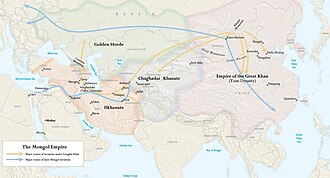
Following the conquest ofDaliin 1253, the former ruling Duan family were appointed as its leaders.[92]Local chieftains were appointed asTusi,recognized as imperial officials by the Yuan,Ming,andQing-era governments, principally in the province ofYunnan.Succession for the Yuan dynasty, however, was an intractable problem, later causing much strife and internal struggle. This emerged as early as the end of Kublai's reign. Kublai originally named his eldest son,Zhenjin,as the crown prince, but he died before Kublai in 1285.[93]Thus, Zhenjin's third son, with the support of his mother Kökejin and the ministerBayan,succeeded the throne and ruled asTemür Khan,or Emperor Chengzong, from 1294 to 1307. Temür Khan decided to maintain and continue much of the work begun by his grandfather. He also made peace with the western Mongol khanates as well as neighboring countries such as Vietnam,[94]which recognized his nominal suzerainty and paid tributes for a few decades. However, the corruption in the Yuan dynasty began during the reign of Temür Khan.
Külüg Khan[edit]
Külüg Khan(Emperor Wuzong) came to the throne after the death of Temür Khan. Unlike his predecessor, he did not continue Kublai's work, largely rejecting his objectives. Most significantly he introduced a policy called "New Deals", focused on monetary reforms. During his short reign (1307–11), the government fell into financial difficulties, partly due to bad decisions made by Külüg. By the time he died, China was in severe debt and the Yuan court faced popular discontent.[15]: 323
Ayurbarwada Buyantu Khan[edit]
The fourth Yuan emperor,Buyantu Khan(born Ayurbarwada), was a competent emperor. He was the first Yuan emperor to actively support and adopt mainstreamChinese cultureafter the reign of Kublai, to the discontent of some Mongol elite.[95]He had been mentored byLi Meng,aConfucianacademic. He made many reforms, including the liquidation of theDepartment of State Affairs(Thượng thư tỉnh), which resulted in the execution of five of the highest-ranking officials.[95]Starting in 1313 the traditionalimperial examinationswere reintroduced for prospective officials, testing their knowledge on significant historical works. Also, he codified much of the law, as well as publishing or translating a number of Chinese books and works.
Gegeen Khan and Yesün Temür[edit]
EmperorGegeen Khan,Ayurbarwada's son and successor, ruled for only two years, from 1321 to 1323. He continued his father's policies to reform the government based on the Confucian principles, with the help of his newly appointed grandchancellorBaiju. During his reign, theDa Yuan Tong Zhi(《 đại nguyên thông chế 》;'Comprehensive Institutions of the Great Yuan''), a huge collection of codes and regulations of the Yuan dynasty begun by his father, was formally promulgated. Gegeen was assassinated in acoupinvolving five princes from a rival faction, perhaps steppe elite opposed to Confucian reforms. They placedYesün Temür(or Taidingdi) on the throne, and, after an unsuccessful attempt to calm the princes, he also succumbed toregicide.
Before Yesün Temür's reign, China had been relatively free from popular rebellions after the reign of Kublai. Yuan control, however, began to break down in those regions inhabited by ethnic minorities. The occurrence of these revolts and the subsequent suppression aggravated the financial difficulties of the Yuan government. The government had to adopt some measure to increase revenue, such as selling offices, as well as curtailing its spending on some items.[96]
Jayaatu Khan Tugh Temür[edit]

When Yesün Temür died in Shangdu in 1328,Tugh Temürwas recalled toKhanbaliqby theQipchaqcommanderEl Temür.He was installed as the emperor (Emperor Wenzong văn tông hoàng đế ) in Khanbaliq, while Yesün Temür's sonRagibaghsucceeded to the throne in Shangdu ( thương đô ) with the support of Yesün Temür's favorite retainer Dawlat Shah. Gaining support from princes and officers in Northern China and some other parts of the dynasty, Khanbaliq-based Tugh Temür eventually won the civil war against Ragibagh known as theWar of the Two Capitals.Afterwards, Tugh Temür abdicated in favour of his brotherKusala,who was backed by Chagatai KhanEljigidey,and announced Khanbaliq's intent to welcome him. However, Kusala suddenly died only four days after a banquet with Tugh Temür. He was supposedly killed with poison by El Temür, and Tugh Temür then remounted the throne. Tugh Temür also managed to send delegates to the western Mongol khanates such asGolden HordeandIlkhanateto be accepted as the suzerain of Mongol world.[97]However, he was mainly a puppet of the powerful official El Temür during his latter three-year reign. El Temür purged pro-Kusala officials and brought power to warlords, whose despotic rule clearly marked the decline of the dynasty.
Due to the fact that the bureaucracy was dominated by El Temür, Tugh Temür is known for his cultural contribution instead. He adopted many measures honoringConfucianismand promotingChinese cultural values.His most concrete effort to patronize Chinese learning was founding the Academy of the Pavilion of the Star of Literature (Khuê chương các học sĩ viện), first established in the spring of 1329 and designed to undertake "a number of tasks relating to the transmission of Confucian high culture to the Mongolian imperial establishment" ( nho giáo thôi sùng ). The academy was responsible for compiling and publishing a number of books, but its most important achievement was its compilation of a vast institutionalcompendiumnamedJingshi Dadian(Kinh thế đại điển). Tugh Temür supportedZhu Xi'sNeo-Confucianismand also devoted himself inBuddhism.
Toghon Temür[edit]
After the death of Tugh Temür in 1332 and subsequent death ofRinchinbal(Emperor Ningzong) the same year, the 13-year-oldToghon Temür(Emperor Huizong), the last of the nine successors of Kublai Khan, was summoned back fromGuangxiand succeeded to the throne. After El Temür's death,Bayanbecame as powerful an official as El Temür had been in the beginning of his long reign. As Toghon Temür grew, he came to disapprove of Bayan's autocratic rule. In 1340 he allied himself with Bayan's nephewToqto'a,who was in discord with Bayan, and banished Bayan by coup. With the dismissal of Bayan, Toqto'a seized the power of the court. His first administration clearly exhibited fresh new spirit. He also gave a few early signs of a new and positive direction in central government. One of his successful projects was to finish the long-stalledofficial historiesof theLiao,Jin,andSongdynasties, which were eventually completed in 1345. Yet, Toqto'a resigned his office with the approval of Toghon Temür, marking the end of his first administration, and he was not called back until 1349.
Decline of the empire[edit]


The final years of the Yuan dynasty were marked by struggle, famine, and bitterness among the populace. In time, Kublai Khan's successors lost all influence on other Mongol lands across Asia, while the Mongols beyond the Middle Kingdom saw them as too Chinese. Gradually, they lost influence in China as well. The reigns of the later Yuan emperors were short and marked by intrigues and rivalries. Uninterested in administration, they were separated from both the army and the populace, and China was torn by dissension and unrest. Outlaws ravaged the country without interference from the weakening Yuan armies.
From the late 1340s onwards, people in the countryside suffered from frequent natural disasters such as droughts, floods and the resulting famines, and the government's lack of effective policy led to a loss of popular support. In 1351, theRed Turban Rebellionled by Song loyalists started and grew into a nationwide uprising and the Song loyalists established a renewed Song dynasty in 1351 with its capital at Kaifeng. In 1354, when Toghtogha led a large army to crush the Red Turban rebels, Toghon Temür suddenly dismissed him for fear of betrayal. This resulted in Toghon Temür's restoration of power on the one hand and a rapid weakening of the central government on the other. He had no choice but to rely on local warlords' military power, and gradually lost his interest in politics and ceased to intervene in political struggles. He fled north toShangdufrom Khanbaliq (present-day Beijing) in 1368 after the approach of the forces of theMing dynasty(1368–1644), founded byZhu Yuanzhangin the south. Zhu Yuanzhang was a former Duke and commander in the army of the Red Turban Song dynasty and assumed power as Emperor after the death of the Red Turban Song EmperorHan Lin'er,who had tried to regain Khanbaliq, which eventually failed, and who died inYingchang(located in present-dayInner Mongolia) two years later (1370). Yingchang was seized by the Ming shortly after his death. Some royal family members still live inHenantoday.[98][relevant?]
ThePrince of Liang,Basalawarmiestablished a separate pocket of resistance to the Ming inYunnanandGuizhou,but his forces were decisively defeated by the Ming in 1381. By 1387 the remaining Yuan forces inManchuriaunderNaghachuhad alsosurrendered to the Ming dynasty.The Yuan remnants retreated to Mongolia after the fall of Yingchang to the Ming in 1370, where the name Great Yuan (Đại nguyên) was formally carried on, and is known as theNorthern Yuan dynasty.
Impact[edit]


A rich cultural diversity developed during the Yuan dynasty. The major cultural achievements were the development ofdramaand thenoveland the increased use of thewritten vernacular.Arts and culture also greatly developed and flourished during the Yuan dynasty. There was a widespread introduction of blue and white painted porcelain, as well as a major change to Chinese painting.[99]The political unity of China and much of central Asia promoted trade between East and West. The Mongols' extensive West Asian and European contacts produced a fair amount of cultural exchange. The other cultures and peoples in theMongol Empirealso very much influenced China. It had significantly eased trade and commerce across Asia until its decline; the communications between Yuan dynasty and its ally and subordinate inPersia,theIlkhanate,encouraged this development.[100][101]Buddhism had a great influence in the Yuan government, and the Tibetan-riteTantric Buddhismhad significantly influenced China during this period. The Muslims of the Yuan dynasty introducedMiddle Easterncartography,astronomy,medicine, clothing, and cuisine in East Asia. Eastern crops such ascarrots,turnips,new varieties oflemons,eggplants,andmelons,high-quality granulatedsugar,andcottonwere all either introduced or successfully popularized during the Yuan dynasty.[14]: 611
Western musical instruments were introduced to enrich Chinese performing arts. From this period dates the conversion toIslam,by Muslims of Central Asia, of growing numbers of Chinese in the northwest and southwest.NestorianismandRoman Catholicismalso enjoyed a period of toleration.Buddhism(especiallyTibetan Buddhism) flourished, althoughTaoismendured certain persecutions in favor of Buddhism from the Yuan government.Confuciangovernmental practices and examinations based on theClassics,which had fallen into disuse in north China during the period of disunity, were reinstated by the Yuan court, probably in the hope of maintaining order over Han society. Advances were realized in the fields of travel literature,cartography,geography,and scientific education.

Certain Chinese innovations and products, such as purifiedsaltpetre,printing techniques,porcelain,playing cards,and medical literature, were exported to Europe and Western Asia, while the production of thin glass andcloisonnébecame popular in China. The Yuan exercised a profound influence on the Chinese Ming dynasty. The Ming Emperor Zhu Yuanzhang (1368–97) admired the Mongols' unification of China and adopted its garrison system.[14]: 611

Aside from theancient Roman embassies,thefirst recorded travels by Europeans to China and backdate from this time. The most famous traveler of the period was theVenetianMarco Polo,whose account of his trip to "Cambaluc," the capital of the Great Khan, and of life there astounded the people of Europe. The account of his travels,Il milione(or,The Million,known in English as theTravels of Marco Polo), appeared about the year 1299. Some doubted the accuracy of Marco Polo's accounts due to the lack of mentioning the Great Wall of China, chopsticks, tea houses – which would have been a prominent sight since Europeans had yet to adopt a tea culture – as well the practice of foot binding by the women in capital of the Great Khan. Recent studies however show that Polo's account is largely accurate and unique.[104]
The Yuan undertook extensive public works. Among Kublai Khan's top engineers and scientists was the astronomerGuo Shoujing,who was tasked with many public works projects and helped the Yuan reform thelunisolar calendarto provide an accuracy of 365.2425 days of the year,[105]which was only 26 seconds off the modernGregorian calendar's measurement. Road and water communications were reorganized and improved. To provide against possible famines,granarieswere ordered built throughout the empire. The city of Beijing was rebuilt with new palace grounds that included artificial lakes, hills and mountains, and parks. During the Yuan period, Beijing became the terminus of theGrand Canal of China,which was completely renovated. These commercially oriented improvements encouraged overland and maritime commerce throughout Asia and facilitated direct Chinese contacts with Europe. Chinese travelers to the West were able to provide assistance in such areas as hydraulic engineering. Contacts with the West also brought the introduction to China of a major food crop,sorghum,along with other foreign food products and methods of preparation.
The Yuan dynasty was the first dynasty founded by non-Hanethnicity that ruled all ofChina proper.In the historiography of Mongolia, it is generally considered to be the continuation of the Mongol Empire. Mongols are widely known to worship the Eternal Heaven, and according to the traditional Mongolian ideology Yuan is considered to be "the beginning of an infinite number of beings, the foundation of peace and happiness, state power, the dream of many peoples, besides it there is nothing great or precious."[citation needed]In traditionalhistoriography of China,on the other hand, the Yuan dynasty is usually considered to be the legitimate dynasty between theSong dynastyand theMing dynasty.Note, however, Yuan dynasty is traditionally often extended to cover the Mongol Empire beforeKublai Khan's formal establishment of the Yuan in 1271, partly because Kublai officially honoured prior rulers of the Mongol Empire as Yuan emperors by conferring themposthumous namesandtemple names.Despite the traditional historiography as well as the official views (including the government of the Ming dynasty which overthrew the Yuan dynasty), there also exist Chinese people[who?]who did not consider the Yuan dynasty as a legitimate dynasty of China, but rather as a period of foreign domination. The latter believe that Han Chinese were treated assecond-class citizens,[citation needed]and that China stagnated economically and scientifically.
The dynasty chose white as its imperial color, which corresponds to the Metal element according to the theory of theFive Elements(wuxing). The Metal element does not follow from the Song's dynastic element Five in the creation sequence of the five elements. Instead, it follows from theJin dynasty's dynastic element Earth. Although the Yuan did not openly announce it, its choice of white as its imperial color suggests that it considered Jin, another conquest dynasty, rather than the Han-Chinese Song dynasty, as its rightful predecessor.[106]
The dragon clothing of Imperial China was used by theIlkhanids,the ChineseHuangdi(Emperor) title was used by the Ilkhanids due to heavy clout upon the Mongols of the Chinese system of politics. Seals with Chinese characters were created by the Ilkhanids themselves besides the seals they received from the Yuan dynasty which contain references to a Chinese government organization.[107]: 46
Government[edit]

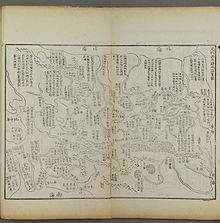
The structure of the Yuan government took shape during the reign ofKublai Khan(1260–1294). While some changes took place such as the functions of certain institutions, the essential components of the government bureaucracy remained intact from the beginning to the end of the dynasty in 1368.
The system of bureaucracy created by Kublai Khan reflected various cultures in the empire, including that of theHans,Khitans,Jurchens,Mongols,andTibetan Buddhists.While the official terminology of the institutions may indicate the government structure was almost purely that of native Chinese dynasties, the Yuan bureaucracy actually consisted of a mix of elements from different cultures. The Chinese-style elements of the bureaucracy mainly came from the nativeTang,Song,as well as KhitanLiaoand JurchenJindynasties. Chinese advisers such asLiu BingzhongandYao Shugave strong influence to Kublai's early court, and the central government administration was established within the first decade of Kublai's reign. This government adopted the traditional Chinese tripartitedivision of authorityamongcivil,military, andcensorialoffices, including theCentral Secretariat(Zhongshu Sheng) to manage civil affairs, thePrivy Council(Xu mật viện;Shūmì Yuàn) to manage military affairs, and theCensorateto conduct internal surveillance and inspection. The actual functions of both central and local government institutions, however, showed a major overlap between the civil and military jurisdictions, due to the Mongol traditional reliance on military institutions and offices as the core of governance. Nevertheless, such a civilian bureaucracy, with the Central Secretariat as the top institution that was (directly or indirectly) responsible for most other governmental agencies (such as the traditional Chinese-styleSix Ministries), was created in China. At various times another central government institution called theDepartment of State Affairs(Thượng thư tỉnh;Shangshu Sheng) that mainly dealt with finance was established (such as during the reign ofKülüg Khanor Emperor Wuzong), but was usually abandoned shortly afterwards.
While the existence of these central government departments and the Six Ministries (which had been introduced since theSuiand Tang dynasties) gave a Sinicized image in the Yuan administration, the actual functions of these ministries also reflected how Mongolian priorities and policies reshaped and redirected those institutions. For example, the authority of the Yuan legal system, theMinistry of Justice,did not extend to legal cases involving Mongols andSemu,who had separate courts of justice. Cases involving members of more than one ethnic group were decided by a mixed board consisting of Chinese and Mongols. Another example was the insignificance of theMinistry of Warcompared with native Chinese dynasties, as the real military authority in Yuan times resided in the Privy Council.
TheKingdom of Qocho,Kingdom of Dali,Chiefdom of Bozhou,otherTusikingdoms, and Goryeo were ruled by rulers subject to, and in some cases related to, the Yuan imperial house.[citation needed]
Science and technology[edit]
Mathematics[edit]


Advances in polynomial algebra were made by mathematicians during the Yuan era. The mathematicianZhu Shijie(1249–1314) solvedsimultaneous equationswith up to four unknowns using a rectangular array of coefficients, equivalent to modernmatrices.[108][109]Zhu used a method of elimination to reduce the simultaneous equations to a single equation with only one unknown.[110]His method is described in theJade Mirror of the Four Unknowns,written in 1303. The opening pages contain a diagram ofPascal's triangle.The summation of a finite arithmetic series is also covered in the book.[111]
Guo Shoujingapplied mathematics to the construction of calendars. He was one of the first mathematicians in China to work on spherical trigonometry.[112]Gou derived a cubic interpolation formula for his astronomical calculations.[113]His calendar, theShoushi Li(Thụ thời lịch;'Time Granting Calendar''), was disseminated in 1281 as the official calendar of the Yuan dynasty.[114]The calendar may have been influenced solely by the work ofSong dynastyastronomerShen Kuoor possibly by the work of Arab astronomers.[112]There are no explicit signs of Muslim influences in the Shoushi calendar, but Mongol rulers were known to be interested in Muslim calendars.[114]Mathematical knowledge from the Middle East was introduced to China under the Mongols, and Muslim astronomers broughtArabic numeralsto China in the 13th century.[112]
Medicine[edit]
The physicians of the Yuan court came from diverse cultures.[115]Healers were divided into non-Mongol physicians calledotachiand traditional Mongol shamans. The Mongols characterizedotachidoctors by their use of herbal remedies, which was distinguished from the spiritual cures of Mongol shamanism.[115]Physicians received official support from the Yuan government and were given special legal privileges. Kublai created the Imperial Academy of Medicine to manage medical treatises and the education of new doctors.[116]Confucian scholars were attracted to the medical profession because it ensured a high income and medical ethics were compatible with Confucian virtues.[117][116]
The Chinese medical tradition of the Yuan had "Four Great Schools" that the Yuan inherited from the Jin dynasty. All four schools were based on the same intellectual foundation, but advocated different theoretical approaches toward medicine.[117]Under the Mongols, the practice of Chinese medicine spread to other parts of the empire. Chinese physicians were brought along military campaigns by the Mongols as they expanded towards the west. Chinese medical techniques such asacupuncture,moxibustion,pulse diagnosis,and various herbal drugs and elixirs were transmitted westward to the Middle East and the rest of the empire.[118]Several medical advances were made in the Yuan period. The physicianWei Yilin(1277–1347) invented a suspension method forreducingdislocated joints, which he performed using anesthetics.[119]The Mongol physicianHu Sihuidescribed the importance of a healthy diet in a 1330 medical treatise.[119]
Western medicine was also practiced in China by the Nestorian Christians of the Yuan court, where it was sometimes labeled ashuihuior Muslim medicine.[120]The Nestorian physician Jesus the Interpreter founded the Office of Western Medicine in 1263 during the reign of Kublai.[121]Huihui doctors staffed at two imperial hospitals were responsible for treating the imperial family and members of the court.[116]Chinese physicians opposed Western medicine because itshumoral systemcontradicted theyin-yangand wuxing philosophy underlying traditional Chinese medicine.[117]No Chinese translation of Western medical works is known, but it is possible that the Chinese had access toAvicenna'sThe Canon of Medicine.[120]
Printing and publishing[edit]


The Mongol rulers patronized the Yuan printing industry.[122][123]Chinese printing technology was transferred to the Mongols throughKingdom of Qochoand Tibetan intermediaries.[122]Some Yuan documents such asWang Zhen'sNong Shuwere printed with earthenwaremovable type,a technology invented in the 12th century. However, most published works were still produced through traditionalblock printingtechniques.[124]The publication of a Taoist text inscribed with the name ofTöregene Khatun,Ögedei's wife, is one of the first printed works sponsored by the Mongols. In 1273, the Mongols created the Imperial Library Directorate, a government-sponsored printing office.[122]The Yuan government established centers for printing throughout China.[122]Local schools and government agencies were funded to support the publishing of books.[125]
Private printing businesses also flourished under the Yuan. They published a diverse range of works, and printed educational, literary, medical, religious, and historical texts. The volume of printed materials was vast.[126]In 1312, 1,000 copies of a Buddhist text commented by Cosgi Odsir were printed just within Beijing.[127]By 1328, annual sales of printed calendars and almanacs reached over three million in the Yuan dynasty.[128]
One of the more notable applications of printing technology was theJiaochao,the paper money of the Yuan. Jiaochao were made from the bark of mulberry trees.[127]The Yuan government used woodblocks to print paper money, but switched to bronze plates in 1275.[129]The Mongols experimented with establishing the Chinese-style paper monetary system in Mongol-controlled territories outside of China. The Yuan ministerBoladwas sent to Iran, where he explained Yuan paper money to the Il-khanate court ofGaykhatu.[130]The Il-khanate government issued paper money in 1294, but public distrust of the exotic new currency doomed the experiment.[131]
Foreign observers took note of Yuan printing technology. Marco Polo documented the Yuan printing of paper money and almanac pamphlets calledtacuini.[127]The vizierRashid-al-Dinrecognized that printing was a valuable technological breakthrough, and expressed regret that the Mongol experiment with printing paper money had failed in the Muslim world. Rashid-al-Din's view was not shared by other chroniclers in the Middle East, who were critical of the experiment's disruptive impact on the Il-khanate.[128]
Ceramics[edit]
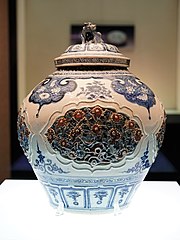
InChinese ceramicsthe period was one of expansion, with the great innovation the development inJingdezhen wareofunderglazepaintedblue and white pottery.This seems to have begun in the early decades of the 14th century, and by the end of the dynasty was mature and well-established. Other major types of wares continued without a sharp break in their development, but there was a general trend to some larger size pieces, and more decoration. This is often seen as a decline from Song refinement. Exports expanded considerably, especially to the Islamic world.
Society[edit]
Imperial lifestyle[edit]
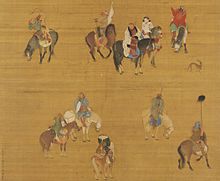
Since its invention in 1269, the'Phags-pa script,a unified script for spellingMongolian,Tibetan,andChineselanguages, was preserved in the court until the end of the dynasty. Most of the Emperors could not masterwritten Chinese,but they could generally converse well in the language. The Mongol custom of long standingqudamarriage alliance with other Mongol clans – theOnggiratand the Ikeres – kept the imperial blood purely Mongol until the reign ofTugh Temur(Emperor Wenzong), whose mother was aTangutconcubine. The Mongol Emperors had built large palaces and pavilions, but some still continued to live as nomads at times. Tugh Temür was an example of a Yuan emperor who actively sponsored cultural activities; including in his imperial capacity and in his personal activities such as writingpoetry,painting, readingChinese classical texts,and ordering the compilation of books.[132]
The average Mongol garrison family of the Yuan dynasty seems to have lived a life of decaying rural leisure, with income from the harvests of their Chinese tenants eaten up by costs of equipping and dispatching men for their tours of duty. The Mongols practiced debt slavery, and by 1290 in all parts of the Mongol Empire commoners were selling their children into slavery. Seeing this as damaging to the Mongol nation, Kublai in 1291 forbade the sale abroad of Mongols. Kublai wished to persuade the Chinese that he was becoming increasinglysinicizedwhile maintaining his Mongolian credentials with his own people. He set up a civilian administration to rule, built a capital within China, supported Chinese religions and culture, and devised suitable economic and political institutions for the court. But at the same time he never abandoned his Mongolian heritage.[133]: 488–489
Religion[edit]

There were many religions practiced during the Yuan dynasty, such asBuddhism,Islam,ChristianityandManichaeism.The establishment of the Yuan dynasty had dramatically increased the number ofMuslimsin China. However, unlike the western khanates, the Yuan dynasty never converted to Islam. Instead, Kublai Khan, the founder of the Yuan dynasty, favored Buddhism, especially the Tibetan variants. As a result,Tibetan Buddhismbecame thede factostate religion.The top-level department and government agency known as theBureau of Buddhist and Tibetan Affairs(Chinese:Tuyên chính viện;pinyin:xuānzhèngyuàn) was set up inKhanbaliq(modern Beijing) to superviseBuddhist monksthroughout the empire. Since Kublai Khan only esteemed theSakyasect of Tibetan Buddhism, other religions became less important. He and his successors kept a SakyaImperial Preceptor(Chinese:Đế sư;pinyin:Dìshī) at court. Before the end of the Yuan dynasty, 14 leaders of the Sakya sect had held the post of Imperial Preceptor, thereby enjoying special power.[134]: 59 Furthermore, Mongol patronage of Buddhism resulted in a number of monuments of Buddhist art. Mongolian Buddhist translations, almost all from Tibetan originals, began on a large scale after 1300. Many Mongols of the upper class such as theJalayirand the Oronar nobles as well as the emperors also patronizedConfucianscholars and institutions. A considerable number of Confucian and Chinese historical works were translated into theMongolian language.

At the same time the Mongols imported Central Asian Muslims to serve as administrators in China, the Mongols also sent Hans and Khitans from China to serve as administrators over the Muslim population in Bukhara in Central Asia, using foreigners to curtail the power of the local peoples of both lands.[135]
Genghis Khan and the following Yuan emperors forbade Islamic practices like Halal butchering, forcing Mongol methods of butchering animals on Muslims, and other restrictive degrees continued. Muslims had to slaughter sheep in secret.[136]: 24 Genghis Khan directly called Muslims and Jews "slaves" and demanded that they follow the Mongol method of eating rather than the halal method.Circumcisionwas also forbidden. Jews were also affected and forbidden by the Mongols to eatKosher.[137]
Among all the [subject] alien peoples only the Hui-hui say "we do not eat Mongol food". [Cinggis Qa’an replied:] "By the aid of heaven we have pacified you; you are our slaves. Yet you do not eat our food or drink. How can this be right?" He thereupon made them eat. "If you slaughter sheep, you will be considered guilty of a crime." He issued a regulation to that effect... [In 1279/1280 under Qubilai] all the Muslims say: "if someone else slaughters [the animal] we do not eat". Because the poor people are upset by this, from now on, Musuluman [Muslim] Huihui and Zhuhu [Jewish] Huihui, no matter who kills [the animal] will eat [it] and must cease slaughtering sheep themselves, and cease the rite of circumcision.[138]
The Muslims in the semu class revolted against the Yuan dynasty in theIspah Rebellion,but the rebellion was crushed and the Muslims were massacred by the Yuan loyalist commander Chen Youding. Some Muslim communities had the name in Chinese meaning "barracks" and also meaning "thanks"; many Hui Muslims claim it is because that they played an important role in overthrowing the Mongols and it was named in thanks by the Han Chinese for assisting them.[139]
During theMing conquest of Yunnan,Muslim generalsMu YingandLan Yuled Muslim troops loyal to the Ming dynasty against Mongol and Muslim troops loyal to the Yuan dynasty.[140][136]: 34
Hindustatues were found inQuanzhoudating to the Yuan period.[141][better source needed]
Four-class system[edit]
Structure[edit]
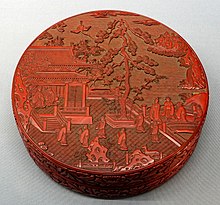

The Mongols had employed foreigners long before the reign of Kublai Khan, the founder of the Yuan dynasty. But during Kublai's reign a hierarchy of reliability was introduced in China. The population was divided into the following classes:[142]
- Mongols.The Mongols were called "Gao-chen"[Chinese script needed](the citizens of the ruling empire) by the conquered Southern Song population.[143]
- Semu,consisting of non-Mongol foreigners from the west andCentral Asia,likeBuddhist Uyghurs from Turfan,Tanguts,Tibetans,Jews,Nestorian Christians, and Muslims from Central Asia.[144][142]
- Han,a category usually referring toHan Chinesepeople, but under Yuan usage referred to various peoples, most of whom were former subjects of theJurchen Jin dynastysuch asHan ChineseinNorthern China,Jurchens,Khitans,but alsoKoreansand other ethnicities who lived north of theHuaihe River[145]: 247 [142]
- Nan(Southerners), or all subjects of the former Southern Song dynasty, including ethnic Han Chinese and minority native ethnic groups insouthern China,as well as the people of theDali Kingdom.They were sometimes called "Manzi" during the Yuan dynasty. They were on the "bottom of the privilege ladder" in Yuan society.[142]
The ordering of the classes and the placement of people in them came down to how loyal and trustworthy to the Mongols they were. This was defined by the date they surrendered to the Mongols and had little to do with their ethnicity. Ethnic Han Chinese could be classified as eitherHan renorNan renwhile Khitans and Jurchens fromQara Khitaiwere not consideredHanbutSemu.[144]The earlier they surrendered to the Mongols, the higher they were placed, while the more they held out, the lower they were ranked. As a result, the Northern Chinese were ranked higher than the Southern Chinese, because the Song dynasty in southern China fought longer and surrendered later.[146]: 264–265 [147]: 426 Similarly, the Uighur and Karluk monarchs were ranked higher than the Korean monarch at court because they surrendered earlier while the Koreans surrendered later. The Uighurs in particular were noted to not have fought at all.[145]: 247 [144]
Foreign administrators[edit]
The Mongols employed people from different regions to oversee different parts of their empire. Central Asian Muslims served as administrators in China while Han people and Khitans from China served as administrators over the Muslim population inBukharain Central Asia. Foreigners were used to curtail the power of the local peoples of both lands.[135]Han people were moved to Central Asian areas like Besh Baliq,Almaliq,andSamarqandby the Mongols where they worked as artisans and farmers.[148]Alanswere recruited into the Mongol forces with one unit called"Right Alan Guard"which was combined with "recently surrendered" soldiers, Mongols, and Chinese soldiers stationed in the area of the formerKingdom of Qochoand in Besh Balikh the Mongols established a Chinese military colony led by Chinese general Qi Gongzhi.[145]: 255 After the Mongol conquest of Central Asia by Genghis Khan, foreigners were chosen as administrators of gardens and fields in Samarqand while co-management with Chinese and Khitans was required since Muslims were not allowed to manage without them.[149][150]The Yuan-appointed Governor of Samarqand was a Khitan by the name of Ahai. He was from theQara Khitai,held the title Taishi, and was familiar with Chinese culture.[149]Han officials and colonists weresent by the Yuan dynastyto areas ofLingbei provinceincludingHenning Circuit,Yilan Prefecture,andQian Prefecture.[151]
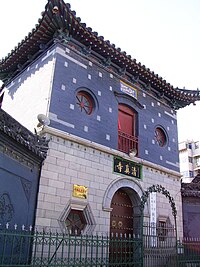
Anti-Chinese policies[edit]
Politically, the system of government created by Kublai Khan was the product of a compromise between Mongolian patrimonialfeudalismand the traditional Chineseautocratic-bureaucraticsystem. Nevertheless, socially the educated Chineseelitewere in general not given the degree of esteem that they had been accorded previously under native Chinese dynasties. Although the traditional Chinese elite were not given their share of power, the Mongols and theSemupeople (various allied groups fromCentral Asiaand the western end of the empire) largely remained strangers to the mainstreamChinese culture,and this dichotomy gave the Yuan regime a somewhat strong "colonial"coloration.[152]The unequal treatment is possibly due to the fear of transferring power to the ethnic Chinese under their rule. The Mongols andSemuwere given certain advantages in the dynasty, and this would last even after the restoration of theimperial examinationin the early 14th century. In general there were very few North Chinese or Southerners reaching the highest-post in the government compared with the possibility that Persians did so in theIlkhanate.[153]Later theYongle Emperorof theMing dynastyalso mentioned the discrimination that existed during the Yuan dynasty. In response to an objection against the use of "barbarians" in his government, the Yongle Emperor answered: "Discrimination was used by the Mongols during the Yuan dynasty, who employed only" Mongols and Tartars "and discarded northern and southern Chinese and this was precisely the cause that brought disaster upon them."[154]However, ordinary Mongol families fell into extreme poverty in both Mongolia and China proper, and elite positions were increasingly penetrated by ethnic Han.[155][156]: 467
Anti-Semupolicies[edit]
Despite the high position given to Muslims, some policies of the Yuan emperors severely discriminated against them, restricting Halal slaughter and other Islamic practices like circumcision, as well asKosherbutchering for Jews, forcing them to eat food the Mongol way.[138]Toward the end, corruption and the persecution became so severe that Muslim generals joinedHanin rebelling against the Mongols. The Ming founderZhu Yuanzhanghad Muslim generals likeLan Yuwho rebelled against the Mongols and defeated them in combat. Some Muslim communities had a Chinese surname Yíng (Doanh) which means, amongst other definitions, both "barracks" and "thanks". Many Hui Muslims claim that because they played an important role in overthrowing the Mongols, this surname was given in thanks by the Han Chinese for assisting them.[139][relevant?]During the war fighting the Mongols, among the Ming Emperor Zhu Yuanzhang's armies was the Hui Muslim Feng Sheng.[157]The Muslims in theSemuclass also revolted against the Yuan dynasty in theIspah Rebellionbut the rebellion was crushed and the Muslims were massacred by the Yuan loyalist commander Chen Youding.
The Muslim merchants in Quanzhou who engaged in maritime trade enriched their families which encompassed their political and trade activities as families. Historians see the violent Chinese backlash that happened at the end of the Yuan dynasty against the wealth of the Muslim andSemuas something inevitable, however anti-Muslim and anti-Semulaws had already been passed by the Yuan dynasty. In 1340 all marriages were forced to follow Confucian principles in marriage regulations, in 1329 all foreign holy men including Muslims had tax exemptions revoked, in 1328 the position of Muslim Qadi was abolished after its powers were limited in 1311. This resulted in anti-Mongol sentiment among Muslims so some anti-Yuan rebels in the mid 14th century were joined by Muslims. In 1357–1367 the Yisibaxi Muslim Persian garrison started a revolt against the Yuan dynasty in Quanzhou and southern Fujian. Persian merchants Amin ud-Din (Amiliding) and Saif ud-Din Saifuding led the revolt. Persian official Yawuna assassinated both Amin ud-Din and Saif ud-Din in 1362 and took control of the Muslim rebel forces. For five years the Muslim rebels tried to strike north and took over some parts of Xinghua but were defeated at Fuzhou two times and failed to take it. Yuan provincial loyalist forces from Fuzhou defeated the Muslim rebels in 1367 after A Muslim rebel officer named Jin Ji defected from Yawuna.[158]: 121 [159]
Criticism[edit]
The historianFrederick W. Motewrote that the usage of the term "social classes" for this system was misleading and that the position of people within the four-class system was not an indication of their actual social power and wealth, but just entailed "degrees of privilege" to which they were entitled institutionally and legally, so a person's standing within the classes was not a guarantee of their standing, since there were rich and well socially standing Chinese while there were less rich Mongol andSemuthan there were Mongol andSemuwho lived in poverty and were ill-treated.[160]
Japanese historians like Uematsu, Sugiyama and Morita criticized the perception that a four-class system existed under Mongol rule and Funada Yoshiyuki questioned the very existence of theSemuas a class.[161]
Administrative divisions[edit]

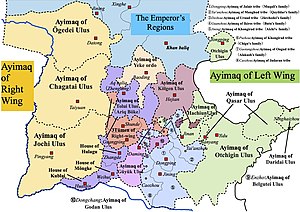
The territory of the Yuan dynasty was divided into the Central Region (Phúc lí) governed by theCentral Secretariatand places under control of various provinces (Hành tỉnh) or Branch Secretariats (Hành trung thư tỉnh), as well as the region under theBureau of Buddhist and Tibetan Affairs.
The Central Region, consisting of present-dayHebei,Shandong,Shanxi,the south-eastern part of present-dayInner Mongoliaand theHenanareas to the north of theYellow River,was considered the most important region of the dynasty and directly governed by the Central Secretariat (or Zhongshu Sheng,Trung thư tỉnh) atKhanbaliq(modernBeijing); similarly, another top-level administrative department called the Bureau of Buddhist and Tibetan Affairs (Chinese:Tuyên chính viện;pinyin:xuānzhèngyuàn)held administrative ruleover the whole of modern-dayTibetand a part ofSichuan,QinghaiandKashmir.
Branch Secretariats or simplyprovinces,were provincial-level administrative organizations or institutions, though they were not exactly provinces in modern sense. There were eleven "regular" provinces in Yuan dynasty,[162]and their administrations were subordinated to the Central Secretariat.
Below the level of provinces, the largest political division was thecircuit(Đạo), followed bylù(Lộ),fǔ(Phủ), andzhōu(Châu). These are three kinds of prefecture-like divisions. The lowest political division was thecounty(Huyện).
Basically,lùwere higher thanfǔ,which were higher thanzhōu.However, the actual relationship between them could be very complicated. All oflù,fǔ,andzhōucould administer counties. Somefǔandzhōuwere directly administered by the province, while some existed inside alù.Alùusually administered several counties, along with severalfǔandzhōu,and thefǔorzhōuthemselves could also administer their own counties. As a result, it is impossible to delineate exactly how many tiers of divisions there were under a province.
This government structure at the provincial level was later inherited and modified by theMingandQingdynasties.
Gallery[edit]
-
Magic squarein Arabic numerals (Yuan dynasty)
-
smeltingmachines (Yuan dynasty)
-
Water wheel (Yuan dynasty)
-
Water hammer (Yuan dynasty)
-
Weaving machine (Yuan dynasty)
-
water mill gear (Yuan dynasty)
-
loom (Yuan dynasty)
-
Yuan painting (Zhao Mengfu)
-
Chuangzi Nu (Yuan dynasty)[163]
-
Military costume.
-
Yuan painting of a legendary figure riding on adragon.
-
Yuancavalry
-
Yuan Mongol soldier
-
Genghis Khan's grandson,Kublai Khanduring his youth
-
Mongol rider (Yuan dynasty)
-
Chinese stone inscription of aNestorianChristian CrossfromCross TempleinBeijing(then called Dadu, orKhanbaliq), dated to the Yuan dynasty
See also[edit]
| History of theMongols |
|---|
 |
- List of emperors of the Yuan dynasty
- Mughal Empire
- History of Mongolia
- History of China
- Administrative divisions of the Yuan dynasty
- Yuan dynasty in Inner Asia
- Yuan dynasty coinage
- Islam during the Yuan dynasty
- Europeans in Medieval China
- Hua-Yi distinction
- Jun ware
- List of largest empires
- Wu Qiuyan
Notes[edit]
- ^abThe precise status ofGoryeo under Mongol ruleis unclear. While Goryeo was a vassal of the Yuan dynasty, many scholars, such asTan Qixiang,regard it as an autonomous state outside the Yuan territory;[2][3][4]others regard it as an integral part of the Yuan territory.
- ^abAs per modern historiographical norm, the "Yuan dynasty" in this article refers exclusively to the realm based inDadu(present-dayBeijing). However, theHan-style dynastic name "Great Yuan" (Đại nguyên) as proclaimed by Kublai in 1271, as well as the claim to Chinese political orthodoxy were meant to be applied to the entireMongol Empire.[8][12]In spite of this, "Yuan dynasty" is rarely used in the broad sense of the definition by modern scholars due to thedisintegrated natureof the Mongol Empire.
- ^abcdSince the enthronement ofGenghis Khan(Thành cát tư hoàng đế;Chéngjísī huángdì) in Spring 1206.[6]Decades beforeKublai Khanannounced the dynastic name "Great Yuan" in 1271, the "Great Mongol State" (Yeke Mongγol Ulus) already used theHan-style title ofEmperor(Chinese:Hoàng đế;pinyin:Huángdì) to translate titleKhagan(Chinese:Hợp hãn;pinyin:Héhàn,Great Khan) inMongolian.[7]Although Kublai Khan announced that he inherited the Mongol throne,Toluid Civil Warbroke out due to opposition from other Mongols.
- ^ModernMongolianform commonly used by Chinese and Mongolian academics:Middle Mongolian:ᠳᠠᠢ
ᠦᠨ
ᠶᠡᠬᠡ
ᠮᠣᠩᠭᠣᠯ
ᠤᠯᠤᠰ,Dai Ön Yeke Mongghul UlusorИх Юань улсin ModernMongolian Cyrillic,Ikh Yuan Üls/Yekhe Yuan Ulus.[11]
References[edit]
Citations[edit]
- ^Walter Koh, ed. (2014)."China under Mongol Rule: The Yuan dynasty"(PDF).China Symposium.
- ^Tan Qixiang;et al. (1987).《 trung quốc lịch sử địa đồ tập 》[The Historical Atlas of China] (in Simplified Chinese). Vol. 7.SinoMaps Press.ISBN978-7-5031-1844-9.
- ^abRossabi 1994,pp. 436–437.
- ^abcdRossabi 1988,p. 77.
- ^Andrew West, ed. (21 December 2006)."'Phags-pa Script: Description ".BabelStone.Retrieved22 April2023.
- ^abSong Lian(1976) [1370]. "Thái tổ bổn kỷ[Chronicle ofTaizu] ".《 nguyên sử 》[History of Yuan] (in Literary Chinese). Beijing: Zhonghua Shuju.
Nguyên niên bính dần, đế đại hội chư vương quần thần, kiếnCửu du bạch đạo,Tức hoàng đế vị ô oát nan hà chi nguyên. Chư vương quần thần cộng thượng tôn hào viếtThành cát tưHoàng đế."
"Inthe first year,on thebingyinday, the emperor greatly assembled the many princes and numerous vassals, and erected his nine-tailed whitetuğ banner,assuming the position ofEmperor of Chinaat the source of theOnon river.And the many princes and numerous vassals together bestowed upon him the reverent titleGenghis Huangdi. - ^Yang Fuxue ( dương phú học ) (1997).Hồi cốt văn hiến sở kiến mông cổ "Hợp hãn" xưng hào chi sử dụng phạm vi[The scope of use of Mongolian "Khagan" title found in Old Uyghur literature].Nội mông cổ xã hội khoa học [Inner Mongolia Social Sciences](5). Cam túc đôn hoàng nghiên cứu viện.S2CID224535800.
- ^abcdefKublai Emperor(18 December 1271),《 kiến quốc hào chiếu 》[Edict to Establish the Name of the State], 《 nguyên điển chương 》[Statutes of Yuan] (in Literary Chinese)
- ^Taagepera, Rein(September 1997)."Expansion and Contraction Patterns of Large Polities: Context for Russia"(PDF).International Studies Quarterly.41(3): 499.doi:10.1111/0020-8833.00053.JSTOR2600793.
- ^abSimon, Karla W. (26 April 2013).Civil Society in China: The Legal Framework from Ancient Times to the 'New Reform Era'.Oxford University Press. p. 39n. 69.ISBN9780190297640.
- ^"ᠮᠣᠩᠭᠣᠯ ᠤᠨ ᠶᠡᠬᠡ ᠶᠤᠸᠠᠨ ᠤᠯᠤᠰ"(in Mongolian). Монголын түүхийн тайлбар толь. 2016.
- ^abcRobinson, David (2019).In the Shadow of the Mongol Empire: Ming China and Eurasia.Cambridge University Press. p. 50.ISBN978-1-108-48244-8.Robinson, David (2009).Empire's Twilight: Northeast Asia Under the Mongols.Harvard–Yenching Institute Monograph Series 68 Studies in East Asian Law. Brill. p. 293.ISBN978-0-674-03608-6.Hodong Kim (2018)."Mongol Perceptions of" China "and the Yuan Dynasty".In Brook, Timothy; Walt van Praag, Michael van; Boltjes, Miek (eds.).Sacred Mandates: Asian International Relations since Chinggis Khan.University of Chicago Press. pp. 45–56.ISBN978-0-226-56293-3.At p. 45.
- ^Mote 1994,p. 624.
- ^abcAtwood, Christopher Pratt (2004).Encyclopedia of Mongolia and the Mongol Empire.Facts On File.ISBN978-0-8160-4671-3.
- ^abSan, Tan Koon (2014).Dynastic China: An Elementary History.Kuala Lumpur: The Other Press. pp. 312, 323.ISBN978-983-9541-88-5.OCLC898313910.
- ^Eberhard, Wolfram (1971).A History of China(3rd ed.). Berkeley, California: University of California Press. p. 232.ISBN0-520-01518-5.[page needed]
- ^Franke, Herbert (1953)."Could the Mongol emperors read and write Chinese?"(PDF).Asia Major.Second series.3(1). Academica Sinica: 28–41.
- ^Saunders, John Joseph(2001) [1971].The History of the Mongol Conquests.University of Pennsylvania Press. p. 116.ISBN978-0-8122-1766-7.
- ^Grousset, René(1939).L'empire des steppes: Attila, Gengis-Khan, Tamerlan[The Empire of Steppes] (in French).
- ^.《 dịch truyện 》[Commentarieson the I Ching] (in Traditional Chinese).
《 thoán 》 viết:Đại tai càn nguyên,Vạn vật tư thủy, nãi thống thiên.
- ^Volker Rybatzki; Alessandra Pozzi; Peter W. Geier; John R. Krueger, eds. (2009).The Early Mongols Language, Culture and History.Studies in Honor of Igor de Rachewiltz on the Occasion of his 80th Birthday. Indiana University Press. p. 116.ISBN9780933070578.
- ^Trần đắc chi (2009). "Quan vu nguyên triều đích quốc hào, niên đại dữ cương vực vấn đề".Bắc phương dân tộc đại học học báo.87(3).
- ^William Honeychurch; Chunag Amartuvshin (2006). "States on Horseback: The Rise of Inner Asian Confederations and Empires". In Miriam T. Stark (ed.).Archaeology of Asia.Wiley Blackwell. pp. 255–278.doi:10.1002/9780470774670.ch12.ISBN9780470774670.
- ^Piero Corradini (1962). "Civil Administration at the Beginning of the Manchu Dynasty: A note on the establishment of the Six Ministries (Liu-pu)".Oriens Extremus.9(2). Harrassowitz Verlag: 133–138.JSTOR43382329.
- ^Elizabeth E. Bacon (September 1971). "Reviewed Work:Central Asia.Gavin Hambly ".American Journal of Sociology(book review).77(2). University of Chicago Press: 364–366.doi:10.1086/225131.JSTOR2776897.
- ^Ronald Findlay; Mats Lundahl (2006). "The First Globalization Episode: The Creation of the Mongol Empire, or the Economics of Chinggis Khan". In Göran Therborn; Habibul Khondker (eds.).Asia and Europe in Globalization.Brill. pp. 13–54.doi:10.1163/9789047410812_005.ISBN9789047410812.
- ^Ebrey 2010,p. 169.
- ^Ebrey 2010,pp. 169–170.
- ^Rossabi 1994,p. 415.
- ^Allsen 1994,p. 392.
- ^Allsen 1994,p. 394.
- ^Rossabi 1994,p. 418.
- ^Rossabi 2012,p. 65.
- ^Wen Haiqing ( ôn hải thanh ) (2012)."Vạn hộ lộ", "Thiên hộ châu" —— mông cổ thiên hộ bách hộ chế độ dữ hoa bắc lộ phủ châu quận thể chế[ "Ten thousand perlu","one thousand perzhou"— the Mongol decimal household administrative system and thelu–fu–zhou–junstructure in northern China].Fudan Academic Journal.No. 4. Archived from the original on 4 March 2016.Retrieved27 May2016.
{{cite magazine}}:CS1 maint: unfit URL (link) - ^Françoise Aubin (1987). "The Rebirth of Chinese Rule in Times of Trouble". In Schram, Stuart Reynolds (ed.).Foundations and Limits of State Power in China.pp. 113–146.ISBN978-0-7286-0139-0.
- ^Ruth Dunnell (1989). "The Fall of the Xia Empire: Sino-Steppe Relations in the Late 12th – Early 13th Centuries". In Seaman, Gary; Marks, Daniel (eds.).Rulers from the Steppe: State Formation on the Eurasian periphery.Ethnographics Monograph Series No. 2. University of Southern California Press. pp. 158–185.ISBN1-878986-01-5.Proceedings of the Soviet-American Academic Symposia "Nomads: Masters of the Eurasian Steppe".
- ^Hu Xiaopeng ( hồ tiểu bằng ) (2001).Oa khoát đài hãn kỷ sửu niên hán quân vạn hộ tiêu trát lạt khảo biện —— kiêm luận kim nguyên chi tế đích hán địa thất vạn hộ[A Study of Xiao Zhala the Han Army commander of 10,000 families in thejichouYear of 1229 during the Period of Ögedei Khan – with a discursus on the Han territory of 70,000 families at the Northern Jin–Yuan boundary].Journal of Northwest Normal University (Social Sciences)(in Simplified Chinese) (6): 36–42.doi:10.3969/j.issn.1001-9162.2001.06.008.
- ^Ke Shaomin(1920). "Volume 146: Biographies #43".New History of Yuan.
- ^Allsen 1994,p. 410.
- ^John Masson Smith Jr. (1998). "Nomads on Ponies vs. Slaves on Horses. Reviewed Work:Mongols and Mamluks: The Mamluk-Īlkhānid War, 1260–1281by Reuven Amitai-Preiss ".Journal of the American Oriental Society.118(1): 54–62.JSTOR606298.
- ^Allsen 1994,p. 411.
- ^Rossabi 1994,p. 422.
- ^Rossabi 1988,p. 51.
- ^Rossabi 1988,p. 53.
- ^Rossabi 1994,p. 423–424.
- ^Morgan 2007,p. 104.
- ^Rossabi 1988,p. 62.
- ^Allsen 1994,p. 413.
- ^Allsen 2001,p. 24.
- ^Morgan 2007,p. 105.
- ^Rossabi 1994,pp. 438.
- ^Lorge, Peter (2010). "Review of David M. Robinson,Empire's Twilight: Northeast Asia under the Mongols.Harvard-Yenching Institute Monograph Series ".China Review International.17(3): 377–379.ISSN1069-5834.JSTOR23733178.
- ^Rossabi 1994,p. 426.
- ^Rossabi 1988,p. 66.
- ^Rossabi 1994,p. 427.
- ^abRossabi 1988,pp. 70–71.
- ^Rossabi 2012,p. 70.
- ^abEbrey 2010,p. 172.
- ^Rossabi 1988,p. 132.
- ^Mote 1994,p. 616.
- ^Rossabi 1988,p. 136.
- ^Mote 1999,p. 461.
- ^Mote 1999,p. 458.
- ^abMote 1999,p. 616.
- ^Rossabi 1994,p. 458.
- ^David Miles; Andrew Scott (2005).Macroeconomics: Understanding the Wealth of Nations.John Wiley & Sons. p. 273.ISBN978-0-470-01243-7.Mike Markowitz (22 May 2016)."Coinage of the Mongols".CoinWeek.Ancient Coin Series. Archived fromthe originalon 23 May 2016.Hartill, David (2005).Cast Chinese Coins: A Historical Catalogue.Trafford.ISBN1-4120-5466-4.
{{cite book}}:CS1 maint: location missing publisher (link)[page needed] - ^Rossabi 2012,p. 72.
- ^Rossabi 2012,p. 74.
- ^Rossabi 2012,p. 62.
- ^Rossabi 1994,p. 463.
- ^Allsen 2001,p. 61.
- ^"Panel VI".The Cresques Project.Catalan Atlas.Cavallo, Jo Ann (2013).The World Beyond Europe in the Romance Epics of Boiardo and Ariosto.University of Toronto Press. p. 32.ISBN978-1-4426-6667-2.
- ^Rossabi 1994,p. 429.
- ^Rossabi 2012,p. 77.
- ^abcMorgan 2007,p. 107.
- ^Michael C. Brose (2014)."Yunnan's Muslim Heritage".In Anderson, James A.; Whitmore, John K. (eds.).China's Encounters on the South and Southwest: Reforging the Fiery Frontier Over Two Millennia.Handbook of Oriental Studies. Section 3 Southeast Asia, Volume: 22. Brill. pp. 135–155.doi:10.1163/9789004282483_006.ISBN978-90-04-28248-3.
- ^Herman, John. E. (2005)."The Mu'ege kingdom: A brief history of a frontier empire in Southwest China".In Di Cosmo, Nicola; Wyatt, Don J (eds.).Political Frontiers, Ethnic Boundaries and Human Geographies in Chinese History.Routledge. pp. 245–285.ISBN978-1-135-79095-0.
- ^John E. Herman (2006)."The Cant of Conquest: Tusi Offices and China's Political Incorporation of the Southwest Frontier".In Crossley, Pamela Kyle; Siu, Helen F.; Sutton, Donald S. (eds.).Empire at the Margins: Culture, Ethnicity, and Frontier in Early Modern China.Vol. 28 of Studies on China. University of California Press. pp. 135–170.ISBN978-0-520-23015-6.
- ^Rossabi 1994,p. 430.
- ^Morgan 2007,p. 106.
- ^Hua, Kaiqi (2018)."The Journey of Zhao Xian and the Exile of Royal Descendants in the Yuan Dynasty (1271–1358)".In Heirman, Ann; Meinert, Carmen; Anderl, Christoph (eds.).Buddhist Encounters and Identities Across East Asia.Leiden: Brill. pp. 196–226.doi:10.1163/9789004366152_008.ISBN978-90-04-36615-2.
- ^Rossabi 2012,pp. 77–78.
- ^Morgan 2007,p. 113.
- ^Charles O. Hucker (1985).A Dictionary of Official Titles in Imperial China.Stanford University Press. p. 66.ISBN978-0-8047-1193-7.Retrieved27 May2016.
- ^abRossabi 1994,p. 473.
- ^Rossabi 2012,p. 111.
- ^abRossabi 2012,p. 113.
- ^Rossabi 1988,p. 218.
- ^Rossabi 1988,pp. 218–219.
- ^Rossabi 1988,pp. 487–488.
- ^Rossabi 1994,p. 488.
- ^Stone, Zofia (2017).Genghis Khan: a Biography.New Delhi: Vij Books India.ISBN978-93-86367-11-2.OCLC975222159.[page needed]
- ^Craughwell, Thomas J. (2010).The Rise and Fall of the Second Largest Empire in History: How Genghis Khan's Mongols almost Conquered the World.Beverly, MA: Fair Winds Press. p. 251.ISBN978-1-61673-851-8.OCLC777020257.
- ^Howard, Michael C. (2012).Transnationalism in Ancient and Medieval Societies: The Role of Cross-Border Trade and Travel.Jefferson, NC: McFarland. p. 84.ISBN978-0-7864-9033-2.OCLC779849477.
- ^abPowers, John; Templeman, David (2012)."Yuan Dynasty".Historical Dictionary of Tibet.Lanham, MD: Scarecrow Press. p. 742.ISBN978-0-8108-7984-3.OCLC801440529.
- ^Hsiao 1994,p. 551.
- ^Hsiao 1994,p. 550.
- ^Thành cát tư hãn trực hệ hậu duệ hiện thân hà nam cự phúc gia phổ vi chứng[Genghis Khan's direct descendants still alive in Henan: huge pedigree chart verifies].Kim nhật an báo(in Chinese). 6 February 2007. Archived fromthe originalon 28 September 2008.
- ^"Yuan dynasty (1279–1368)".National Museum of Asian Art.Teaching China with the Smithsonian.Archivedfrom the original on 7 May 2023.Retrieved3 June2023.
- ^Guzman 1988,pp. 568–570.
- ^Allsen 2001,p. 211.
- ^Birmingham Museum of Art (2010).A Guide to the Collection.London: Giles. p. 28.ISBN978-1-904832-77-5.Archived fromthe originalon 10 September 2011.
- ^"Taicang's five Yuan Dynasty bridges".Suzhou Official Travel and Tourism website.Archived fromthe originalon 21 August 2021 – via China Daily.[better source needed]Ling Dingnian ( lăng đỉnh niên ) (2016).Taicang ShihuaThái thương sử thoại(in Chinese).Social Sciences Literature Press.p. 8.ISBN978-7-5097-8262-0.Sun Hai ( tôn hải ); Lin Xinjian ( lận tân kiến ) (2006).Trung quốc khảo cổ tập thành: Tống nguyên minh thanh[Chinese Archaeology Collections: Song, Yuan, Ming, and Qing] (in Chinese).Central States Ancient Books Publishing House.p. 14.
- ^Haw, Stephen G. (2006),Marco Polo's China: a Venetian in the Realm of Khubilai Khan,Volume 3 of Routledge studies in the early history of Asia, Psychology Press, pp. 52–57,ISBN978-0-415-34850-8Hans Ulrich Vogel (2012).Marco Polo Was in China: New Evidence from Currencies, Salts and Revenues.Brill.ISBN978-90-04-23193-1.
- ^Marilyn Shea (2007)."Guo Shoujing – quách thủ kính".Chinese Astronomy.University of Maine. Archived fromthe originalon 1 December 2008.
- ^Chen, Yuan (2014)."Legitimation Discourse and the Theory of the Five Elements in Imperial China".Journal of Song-Yuan Studies.44(1): 325–364.doi:10.1353/sys.2014.0000.JSTOR44511246.S2CID147099574.
- ^Ho, Kai-Lung (2008)."An Initial Study for Mongolian Factors inside the Rasulid Hexaglot".Central Asiatic Journal.52.Harrassowitz Verlag: 36–54.doi:10.13173/CAJ/2008/1/4.S2CID256889989.
- ^Joseph 2011,p. 196.
- ^Dauben 2007,p. 344.
- ^Dauben 2007,p. 346.
- ^Ho 1985,p. 101.
- ^abcHo 1985,p. 105.
- ^Joseph 2011,p. 247.
- ^abAllsen 2001,p. 172.
- ^abAllsen 2001,p. 142.
- ^abcRossabi 1988,p. 125.
- ^abcAllsen 2001,p. 157.
- ^Lane 2006,pp. 138–139.
- ^abLane 2006,p. 140.
- ^abAllsen 2001,p. 151.
- ^Allsen 2001,p. 155.
- ^abcdAllsen 2001,p. 182.
- ^Wu 1950,p. 460.
- ^Allsen 2001,pp. 176–177.
- ^Wu 1950,p. 463.
- ^Allsen 2001,p. 181.
- ^abcAllsen 2001,p. 183.
- ^abAllsen 2001,p. 184.
- ^Allsen 2001,p. 179.
- ^Allsen 2001,p. 177.
- ^Allsen 2001,p. 178.
- ^Mote 1999,p. 471.
- ^Morris Rossabi (1994) [1978]. "The reign of Khubilai Khan". In Herbert Franke;Denis C. Twitchett(eds.).Alien regimes and border states: 907–1368.The Cambridge History of China. Vol. 6. Cambridge University Press. pp. 414–489.ISBN9780521243315.
- ^Wang Furen (2000)."Early Buddhism in Tibet and the Educational Role of the Monasteries".In Bosworth, Clifford Edmund; Asimov, Muhammad Seyfeydinovich (eds.).History of civilizations of Central Asia.Vol. 4: The Age of achievement, A.D. 750 to the end of the fifteenth century, Pt. II: the achievements. Paris: Unesco Publishing. pp. 54–61.ISBN978-92-3-103654-5.
- ^abBuell, Paul D. (1979). "Sino-Khitan Administration in Mongol Bukhara".Journal of Asian History.13(2): 137–138.JSTOR41930343.
- ^abMichael Dillon (1999).China's Muslim Hui community: migration, settlement and sects.Richmond: Curzon Press. pp. 24, 34.ISBN978-0-7007-1026-3.
- ^Johan Elverskog (2010).Buddhism and Islam on the Silk Road.University of Pennsylvania Press. p. 228.ISBN978-0-8122-4237-9.Retrieved28 June2010.
- ^abLeslie, Donald Daniel (1998)."The Integration of Religious Minorities in China: The Case of Chinese Muslims"(PDF).The Fifty-ninth George Ernest Morrison Lecture in Ethnology.p. 12. Archived fromthe original(PDF)on 17 December 2010.
- ^abGladney, Dru C. (1991).Muslim Chinese: ethnic nationalism in the People's Republic(2nd ed.). Council on East Asian Studies, Harvard University. p. 234.ISBN978-0-674-59495-1.
- ^Tan Ta Sen (2009).Cheng Ho and Islam in Southeast Asia.Singapore: Institute of Southeast Asian Studies. p. 170.ISBN978-981-230-837-5.
- ^Chow, Chung-wah (7 September 2012)."What to do in Quanzhou: China's forgotten historic port".CNN Travel.Archived fromthe originalon 18 February 2013.
- ^abcdMote, Frederick W.(2003).Imperial China 900–1800.Harvard University Press. pp. 489–490.ISBN978-0-674-01212-7.Kupfer, Peter (2008).Youtai - Presence and Perception of Jews and Judaism in China.Peter Lang. p. 189.ISBN978-3-631-57533-8.Zhao, George Qingzhi (2008).Marriage as Political Strategy and Cultural Expression: Mongolian Royal Marriages from World Empire to Yuan Dynasty.Peter Lang. p. 24.ISBN978-1-4331-0275-2.
- ^Natsagdorj, S., and C. Dalai. 2003. "Yuan gürnii üyeiin Mongol oron." In Mongol Ulsiin Tuukh, vol. 2: XII-XIV Zuunii Dund üy, edited by C. Dalai and T. Ishdorj. Ulaanbaatar: Admon, p. 225
- ^abcHaw, Stephen G. (2014).The Semu ren in the Yuan Empire – who were they?.Joint Research Conference of the Institute for Advanced Studies and the Israel Science Foundation. Jerusalem: Academia.edu.Retrieved27 May2016.
- ^abcRossabi, Morris (1983).China Among Equals: The Middle Kingdom and Its Neighbors, 10th-14th Centuries.University of California Press. pp. 247, 255.ISBN978-0-520-04562-0.
- ^Wang Jianping (2007)."Islam and Christianity in the Social Context of China".In Zhao Dunhua (ed.).Dialogues of Philosophies, Religions and Civilizations in the Era of Globalization.San Antonio: Council for Research in Values and Philosophy. pp. 261–278.ISBN9781565182431.[unreliable source?]
- ^Zhang Guangda (2000). "27. China". In M. A. Al-Bakhit; Louis Bazin; Sékéné Mody Cissoko (eds.).History of Humanity: Scientific and Cultural Development.Vol. IV: From the seventh to the sixteenth century. Routledge. pp. 421–446.ISBN9780415093088.
- ^Biran, Michal (2005).The Empire of the Qara Khitai in Eurasian History: Between China and the Islamic World.Cambridge University Press. p. 96.ISBN978-0-521-84226-6.
- ^abW. Barthold, ed. (1928).Turkestan Down to the Mongol Invasion.E.J.W. Gibb memorial series (2nd ed.). p. 451.
- ^Bretschneider, Emil(1888)."The Travels of Ch'ang Ch'un to the West, 1220–1223 recorded by his disciple Li Chi Ch'ang".Mediæval Researches from Eastern Asiatic Sources.Barnes & Noble. pp. 37–108.
- ^《 nguyên sử 》[History of Yuan] (in Traditional Chinese).[not specific enough to verify]
- ^Hsiao 1994,pp. 491–492.
- ^Morgan 1982,p. 135.
- ^Morgan 1982,pp. 124–136.
- ^Endicott-West, Elizabeth (1989).Mongolian Rule in China: Local Administration in the Yuan Dynasty.Harvard-Yenching Institute Monograph Series 29. Brill. p. 86.doi:10.1163/9781684170050_004.ISBN978-1-68417-005-0.
- ^Endicott, Elizabeth (2005). "The Mongols and China: Cultural Contacts and the Changing Nature of Pastoral Nomadism (Twelfth to Early Twentieth Centuries)". In Reuven Amitai; Michal Biran (eds.).Mongols, Turks, and Others: Eurasian Nomads and the Sedentary World.Brill. pp. 461–482.doi:10.1163/9789047406334_021.ISBN978-90-474-0633-4.S2CID245584164.
- ^"China's Islamic Communities Generate Local Histories: The Case of Dachang".China Heritage Quarterly(book review). No. 5. Australia National University. March 2006.ISSN1833-8461.Retrieved27 May2016.
- ^Liu Yingsheng ( lưu nghênh thắng ) (2008)."Muslim Merchants in Mongol Yuan China".In Schottenhammer, Angela (ed.).The East Asian Mediterranean: Maritime Crossroads of Culture, Commerce and Human Migration.Vol. 6 of East Asian economic and socio-cultural studies: East Asian maritime history. Harrassowitz Verlag. pp. 133–144.ISBN978-3-447-05809-4.ISSN1860-1812.
- ^Chaffee, John W. (2018).The Muslim Merchants of Premodern China: The History of a Maritime Asian Trade Diaspora, 750–1400.New Approaches to Asian History. Cambridge University Press. p. 157.doi:10.1017/9780511998492.005.ISBN978-1-108-64009-1.
- ^Mote 2003,p. 492.
- ^Funada Yoshiyuki (6 November 2010).The Image of the Semu People: Mongols, Chinese, and Various Other Peoples under the Mongol Empire.International Roundtable Entitled "The Nature of the Mongol Empire and Its Legacy". Centre for Studies in Asian Cultures and Social Anthropology, Austrian Academy of Sciences, Vienna.Retrieved27 May2016.
- ^Duosang Mongol History, Vol. 1; Zhong-gou Tong-shi; History of Zhong-gou Border Nationalities; The New Yuan-shih[full citation needed]
- ^Leong Kit Meng, ed. (2006)."Siege Weapons Types in Chinese Warfare".Chinese Siege Warfare.Archived fromthe originalon 2 December 2009.
Sources[edit]
- Allsen, Thomas(1994). "The rise of the Mongolian empire and Mongolian rule in north China". InTwitchett, Dennis;Franke, Herbert(eds.).The Cambridge History of China, Volume 6: Alien Regimes and Border States, 907–1368.Cambridge:Cambridge University Press.pp. 321–413.ISBN978-0-521-24331-5.
- Allsen, Thomas (2001).Culture and Conquest in Mongol Eurasia.Cambridge University Press.ISBN978-0-521-80335-9.
- Trần học lâm, Hok-Lam Chan (1991). ""Ta Chin" (Great Golden): The Origin and Changing Interpretations of the Jurchen State Name ".T'oung Pao.Second Series.77(4/5): 253–299.doi:10.1163/156853291X00046.JSTOR4528536.S2CID162236445.
- Dauben, Joseph (2007). "Chinese Mathematics". In Victor Katz (ed.).The Mathematics of Egypt, Mesopotamia, China, India, and Islam: A Sourcebook.Princeton University Press.ISBN978-0-691-11485-9.
- Ebrey, Patricia Buckley (2010) [1996].The Cambridge Illustrated History of China(2nd ed.). Cambridge University Press.ISBN978-0-521-12433-1.
- Guzman, Gregory G. (1988). "Were the Barbarians a Negative or Positive Factor in Ancient and Medieval History?".The Historian.50(4): 558–571.doi:10.1111/j.1540-6563.1988.tb00759.x.
- Ho, Peng Yoke (1985).Li, Qi and Shu: An Introduction to Science and Civilization in China.Hong Kong University Press.ISBN978-0-486-41445-4.
- Hsiao, Ch'i-Ch'ing (1994). "Mid-Yuan Politics". InTwitchett, Dennis;Franke, Herbert(eds.).The Cambridge History of China, Volume 6: Alien Regimes and Border States, 907–1368.Cambridge:Cambridge University Press.pp. 490–560.ISBN978-0-521-24331-5.
- Joseph, George Gheverghese (2011).The Crest of the Peacock: Non-European Roots of Mathematics.Princeton University Press.ISBN978-0-691-13526-7.
- Lane, George (2006).Daily Life in the Mongol Empire.Greenwood Publishing.ISBN978-0-313-33226-5.
- Morgan, David (1982). "Who Ran the Mongol Empire?".The Journal of the Royal Asiatic Society of Great Britain and Ireland.114(1): 124–136.doi:10.1017/S0035869X00159179.S2CID162310870.
- Morgan, David (2007).The Mongols.Wiley-Blackwell.ISBN978-1-4051-3539-9.
- Robinson, David (2017), "Yuan Dynasty",Oxford Bibliographies,Oxford University Press,doi:10.1093/obo/9780199920082-0025,ISBN978-0-19-992008-2
- Rossabi, Morris (1988).Khubilai Khan: His Life and Times.Los Angeles: University of California Press.ISBN978-0-520-06740-0.
- Rossabi, Morris (1994). "The reign of Khubilai Khan". InTwitchett, Dennis;Franke, Herbert(eds.).The Cambridge History of China, Volume 6: Alien Regimes and Border States, 907–1368.Cambridge:Cambridge University Press.pp. 414–489.ISBN978-0-521-24331-5.
- Rossabi, Morris (2012).The Mongols: A Very Short Introduction.Oxford University Press.ISBN978-0-19-984089-2.
- Mote, Frederick W. (1999).Imperial China: 900–1800.Harvard University Press.ISBN978-0-674-01212-7.
- Mote (1994). "Chinese society under Mongol rule, 1215-1368". InTwitchett, Dennis;Franke, Herbert(eds.).The Cambridge History of China, Volume 6: Alien Regimes and Border States, 907–1368.Cambridge:Cambridge University Press.pp. 616–664.ISBN978-0-521-24331-5.
- Smith, John Masson Jr. (January–March 1998). "Review: Nomads on Ponies vs. Slaves on Horses".Journal of the American Oriental Society.118(1): 54–62.doi:10.2307/606298.JSTOR606298.
- Wu, K. T. (1950). "Chinese Printing under Four Alien Dynasties: (916-1368 A. D.)".Harvard Journal of Asiatic Studies.13(3/4): 447–523.doi:10.2307/2718064.ISSN0073-0548.JSTOR2718064.
- Zhao, Gang (January 2006). "Reinventing China: Imperial Qing Ideology and the Rise of Modern Chinese National Identity in the Early Twentieth Century".Modern China.32(1): 3–30.doi:10.1177/0097700405282349.JSTOR20062627.S2CID144587815.
Further reading[edit]
- Birge, Bettine (1995). "Levirate marriage and the revival of widow chastity in Yüan China".Asia Major.3rd series.8(2): 107–146.JSTOR41645519.
- Brook, Timothy.The Troubled Empire: China in the Yuan and Ming Dynasties(History of Imperial China) (Harvard UP, 2010).excerpt
- Chan, Hok-lam; de Bary, W.T., eds. (1982).Yuan Thought: Chinese Thought and Religion Under the Mongols.New York: Columbia University Press.ISBN978-0-231-05324-2.
- Cotterell, Arthur (2007).The Imperial Capitals of China - An Inside View of the Celestial Empire.London, England: Pimlico.ISBN978-1-84595-009-5.
- Dardess, John (1994). "Shun-ti and the end of Yuan rule in China". In Denis C. Twitchett; Herbert Franke (sinologist); John King Fairbank (eds.).The Cambridge History of China: Volume 6, Alien Regimes and Border States, 710–1368.Cambridge University Press. pp. 561–586.ISBN978-0-521-24331-5.
- Ebrey, Patricia Buckley (24 November 2009).Chinese Civilization: A Sourcebook(2nd ed.). Simon and Schuster.ISBN978-1-4391-8839-2.
- Endicott-West, Elizabeth (1986). "Imperial governance in Yüan times".Harvard Journal of Asiatic Studies.46(2): 523–549.doi:10.2307/2719142.JSTOR2719142.
- Endicott-West, Elizabeth (1994). "The Yuan government and society". In Denis C. Twitchett; Herbert Franke (sinologist); John King Fairbank (eds.).The Cambridge History of China: Volume 6, Alien Regimes and Border States, 710–1368.Cambridge University Press. pp. 587–615.ISBN978-0-521-24331-5.
- Langlois, John D. (1981).China Under Mongol Rule.Princeton: Princeton University Press.ISBN978-0-691-10110-1.
- Langlois, John D. (1977). "Report on the research conference: The Impact of Mongol Domination on Chinese Civilization".Sung Studies Newsletter.13(13): 82–90.JSTOR23497251.
- Paludan, Ann (1998).Chronicle of the China Emperors.London, England: Thames & Hudson.ISBN978-0-500-05090-3.
- Saunders, John Joseph (2001) [1971].The History of the Mongol Conquests.University of Pennsylvania Press.ISBN978-0-8122-1766-7.
- Owen, Stephen, "The Yuan and Ming Dynasties," in Stephen Owen, ed.An Anthology of Chinese Literature: Beginnings to 1911.New York:W. W. Norton,1997.pp. 723 743.(Archive).
- "Directory of Scholars Working in Sung, Liao, Chin and Yüan". 1987. "Directory of Scholars Working in Sung, Liao, Chin and Yüan". Bulletin of Sung and Yüan Studies, no. 19. Society for Song, Yuan, and Conquest Dynasty Studies: 224–54.JSTOR23497542.
External links[edit]
- Yuan dynasty
- 1271 establishments in Asia
- 1271 establishments in the Mongol Empire
- 1368 disestablishments in Asia
- 1368 disestablishments in the Mongol Empire
- 13th-century establishments in China
- 13th century in China
- 14th-century disestablishments in China
- 14th century in China
- Borjigin
- Dynasties of China
- Former countries in Chinese history
- Former countries in East Asia
- Former monarchies of East Asia
- Khanates
- Kublai Khan
- Medieval East Asia
- Mongol states
- States and territories established in 1271
- States and territories disestablished in 1368

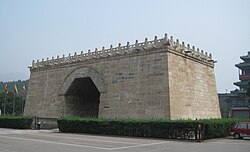

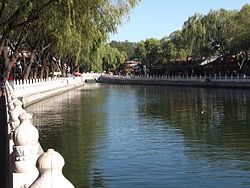
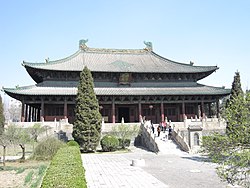


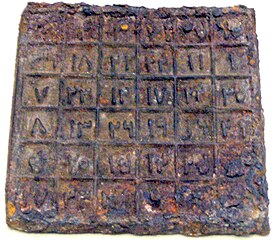
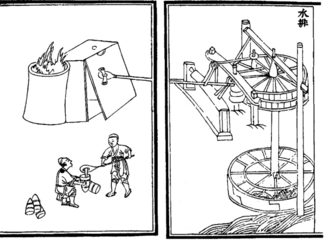
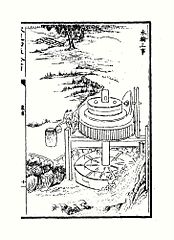
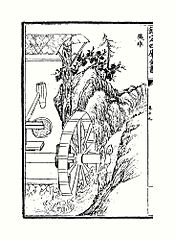
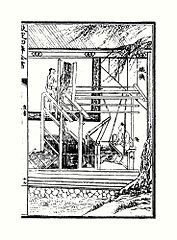

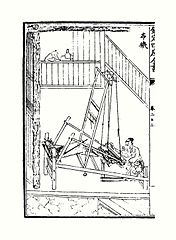

![Chuangzi Nu (Yuan dynasty)[163]](https://upload.wikimedia.org/wikipedia/commons/thumb/8/84/Chuangzi_Nu1.jpg/211px-Chuangzi_Nu1.jpg)
